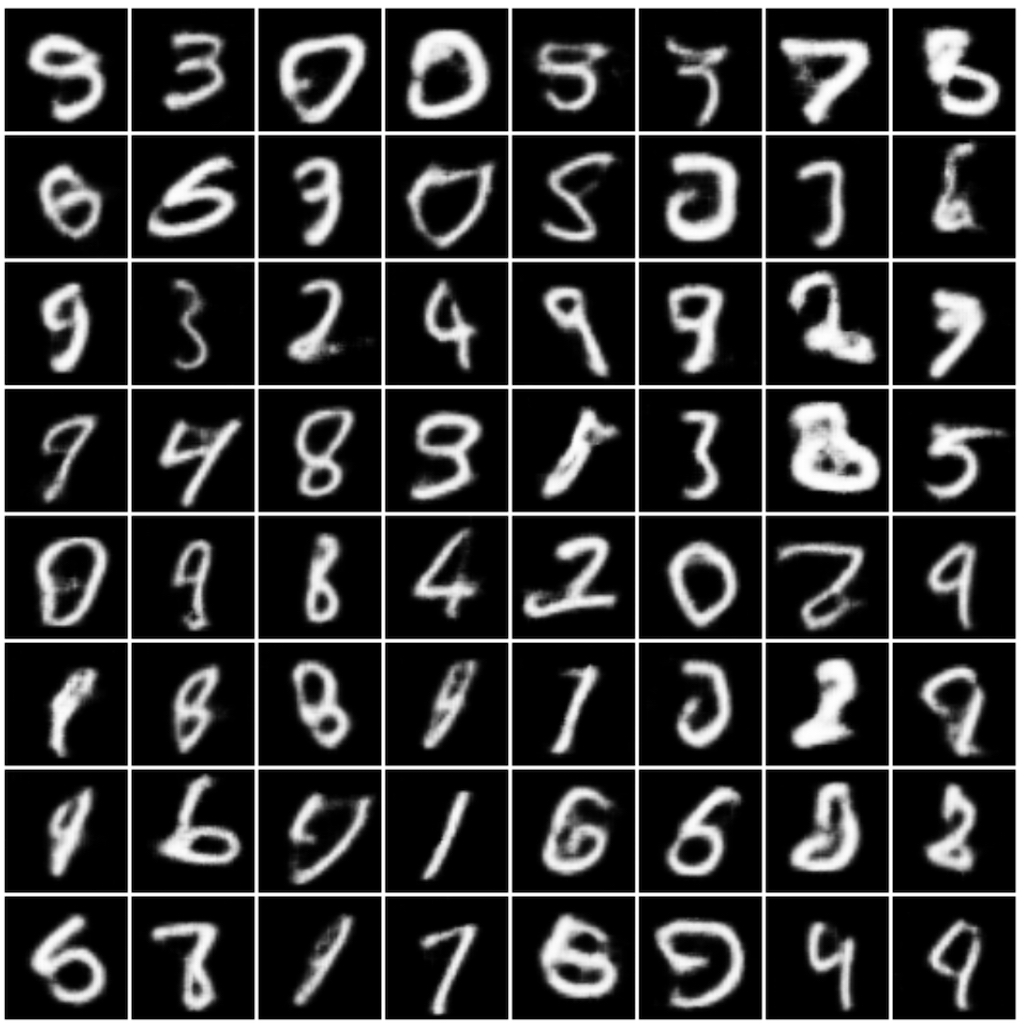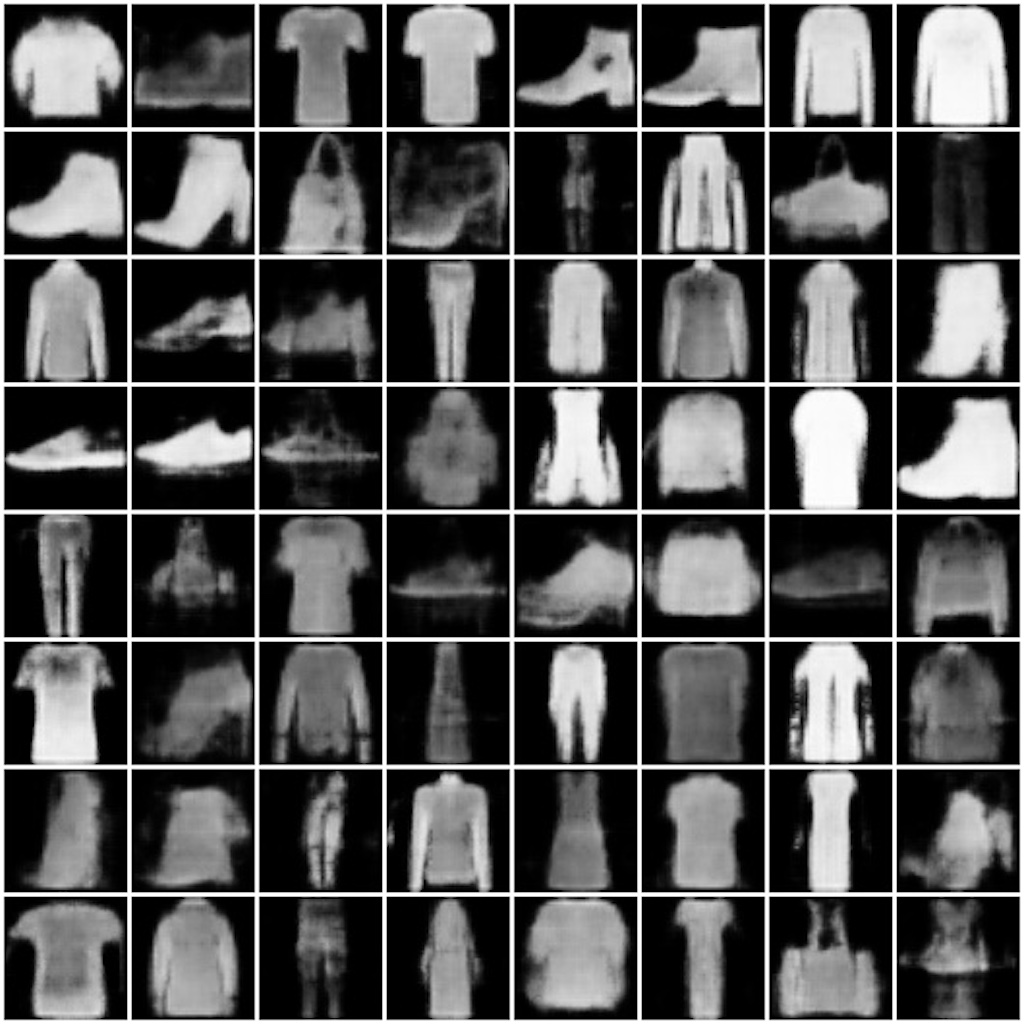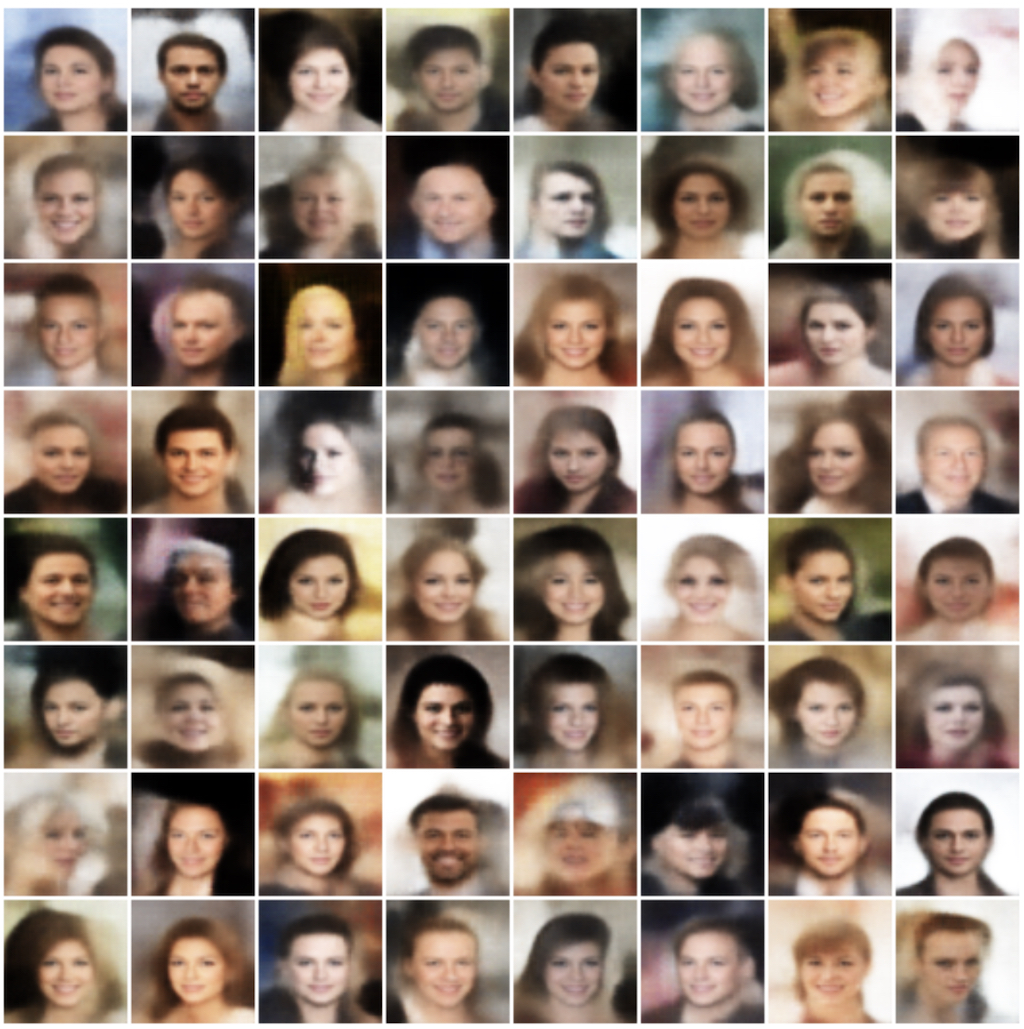Author: Markus Enzweiler, markus.enzweiler@hs-esslingen.de
Convolutional variational autoencoder (VAE) implementation in PyTorch. Supported datasets include MNIST, Fashion MNIST, CIFAR-10/100 and CelebA.
See https://github.com/menzHSE/cv-ml-lecture-notebooks for interactive Jupyter notebooks using this package with additional explanations and visualizations.
Good overviews of variational autoencoders are provided in arXiv:1906.02691 and arXiv:1312.6114.
In our implementation, the input image is not directly mapped to a single latent vector. Instead, it's transformed into a probability distribution within the latent space, from which we sample a latent vector for reconstruction. The process involves:
-
Encoding to Probability Distribution:
- The input image is linearly mapped to two vectors:
- A mean vector.
- A standard deviation vector.
- These vectors define a normal distribution in the latent space.
- The input image is linearly mapped to two vectors:
-
Auxiliary Loss for Distribution Shape:
- We ensure the latent space distribution resembles a zero-mean unit-variance Gaussian distribution (standard normal distribution).
- An auxiliary loss, the Kullback-Leibler (KL) divergence between the mapped distribution and the standard normal distribution, is used in addition to the standard reconstruction loss
- This loss guides the training to shape the latent distribution accordingly.
- It ensures a well-structured and generalizable latent space for generating new images.
-
Sampling and Decoding:
- The variational approach allows for sampling from the defined distribution in the latent space.
- These samples are then used by the decoder to generate new images.
-
Reparametrization Trick:
- This trick enables backpropagation through random sampling, a crucial step in VAEs. Normally, backpropagating through a random sampling process from a distribution with mean
muand standard deviationsigmais challenging due to its nondeterministic nature. - The solution involves initially sampling random values from a standard normal distribution (mean 0, standard deviation 1). These values are then linearly transformed by multiplying with
sigmaand addingmu. This process essentially samples from our target distribution with meanmuand standard deviationsigma. - The key benefit of this approach is that the randomness (initial standard normal sampling) is separated from the learnable parameters (
muandsigma).Muandsigmaare deterministic and differentiable, allowing gradients with respect to them to be calculated during backpropagation. This enables the model to effectively learn from the data.
- This trick enables backpropagation through random sampling, a crucial step in VAEs. Normally, backpropagating through a random sampling process from a distribution with mean
- torch
- torchvision
- torchinfo
- numpy
- Pillow
See requirements.txt.
pip install -r requirements.txt
Supported datasets include MNIST, Fashion MNIST, CIFAR-10/100 and CelebA which are automatically downloaded using torchvision. In case of CelebA, there is a known issue with limited quota on the Google drive where CelebA is hosted.
If you are getting a download error due to exceeded quota, please download CelebA manually from https://graal.ift.ulaval.ca/public/celeba/ and place all downloaded files in the data/celeba directory. No need to unzip anything.
Pretrained models for all datasets are available in the models directory. The models carry information of the maximum number of filters in the conv layers (--max_filters) and the number of latent dimensions (--latent_dims) in their filename. These models use three conv layers with 32/64/128 features (and corresponding transposed conv layers in the decoder) and 64 latent dimensions. To train a VAE model use python train.py.
$ python train.py -h
usage: train.py [-h] [--cpu] [--seed SEED] [--batchsize BATCHSIZE] [--max_filters MAX_FILTERS] [--epochs EPOCHS]
[--lr LR] [--dataset {mnist,fashion-mnist,cifar-10,cifar-100,celeb-a}] --latent_dims LATENT_DIMS
Train a VAE with PyTorch.
options:
-h, --help show this help message and exit
--cpu Use CPU instead of GPU (cuda/mps) acceleration
--seed SEED Random seed
--batchsize BATCHSIZE
Batch size for training
--max_filters MAX_FILTERS
Maximum number of filters in the convolutional layers
--epochs EPOCHS Number of training epochs
--lr LR Learning rate
--dataset {mnist,fashion-mnist,cifar-10,cifar-100,celeb-a}
Select the dataset to use (mnist, fashion-mnist, cifar-10, cifar-100, celeb-a)
--latent_dims LATENT_DIMS
Number of latent dimensions (positive integer)
Example
python train.py --batchsize=128 --epochs=100 --dataset=celeb-a --latent_dims=64
Datasets can be reconstructed using python reconstruct.py. Images depicting original and reconstructed data samples are written to the folder specified by --outdir.
$ python reconstruct.py -h
usage: reconstruct.py [-h] [--cpu] --model MODEL [--rec_testdata]
[--dataset {mnist,fashion-mnist,cifar-10,cifar-100,celeb-a}] --latent_dims LATENT_DIMS
[--max_filters MAX_FILTERS] --outdir OUTDIR
Reconstruct data samples using a VAE with PyTorch.
options:
-h, --help show this help message and exit
--cpu Use CPU instead of GPU (cuda/mps) acceleration
--model MODEL Model filename *.pth
--rec_testdata Reconstruct test split instead of training split
--dataset {mnist,fashion-mnist,cifar-10,cifar-100,celeb-a}
Select the dataset to use (mnist, fashion-mnist, cifar-10, cifar-100, celeb-a)
--latent_dims LATENT_DIMS
Number of latent dimensions (positive integer)
--max_filters MAX_FILTERS
Maximum number of filters in the convolutional layers
--outdir OUTDIR Output directory for the generated samples
Reconstructing MNIST
python reconstruct.py --model=models/mnist/vae_filters_0128_dims_0064.pth --dataset=mnist --latent_dims=64 --outdir=reconstructions/mnist
Reconstructing Fashion MNIST
python reconstruct.py --model=models/fashion-mnist/vae_filters_0128_dims_0064.pth --dataset=fashion-mnist --latent_dims=64 --outdir=reconstructions/fashion-mnist
Reconstructing CelebA
python reconstruct.py --model=models/celeb-a/vae_filters_0128_dims_0064.pth --dataset=celeb-a --latent_dims=64 --outdir=reconstructions/celeb-a
The variational autoencoders are trained in a way that the distribution in latent space resembles a normal distribution (see above). To generate samples from the variational autoencoder, we can sample a random normally distributed latent vector and have the decoder generate an image from that. Use python generate.py to generate random samples.
$ python generate.py -h
usage: generate.py [-h] [--cpu] [--seed SEED] --model MODEL --latent_dims LATENT_DIMS [--max_filters MAX_FILTERS]
[--nsamples NSAMPLES] --outdir OUTDIR [--nimg_channels NIMG_CHANNELS]
Generate samples from a VAE with PyTorch.
options:
-h, --help show this help message and exit
--cpu Use CPU instead of GPU (cuda/mps) acceleration
--seed SEED Random seed
--model MODEL Model filename *.pth
--latent_dims LATENT_DIMS
Number of latent dimensions (positive integer)
--max_filters MAX_FILTERS
Maximum number of filters in the convolutional layers
--nsamples NSAMPLES Number of samples to generate
--outdir OUTDIR Output directory for the generated samples
--nimg_channels NIMG_CHANNELS
Number of image channels (1 for grayscale, 3 for RGB)
Sample from the VAE models trained on MNIST
python generate.py --model=models/mnist/vae_filters_0128_dims_0064.pth --latent_dims=64 --outdir=./samples/mnist --nimg_channels=1 --nsamples=64
Sample from the VAE models trained on Fashion MNIST
python generate.py --model=models/fashion-mnist/vae_filters_0128_dims_0064.pth --latent_dims=64 --outdir=./samples/fashion-mnist --nimg_channels=1 --nsamples=64
Sample from the VAE models trained on CelebA
python generate.py --model=models/celeb-a/vae_filters_0128_dims_0064.pth --latent_dims=64 --outdir=./samples/celeb-a/ --nimg_channels=3 --nsamples=64





